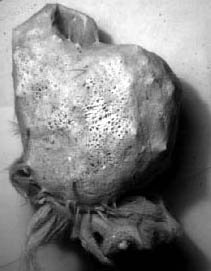



Hexactinellida: Life History and Ecology








The hexactinellids are exclusively marine. Today, the roughly 500 species are mostly known from deeper waters, 200 to 2,000 meters. Many modern hexactinellids are found living on soft substrates. Fossil hexactinellids are often found in strata of fine-grained limestones and shales, suggesting that the group has been associated with quiet waters upon which soft sediments slowly accumulate for their entire history. Although they are most common at great depths today, they are more abundant and diverse at shallower depths of the polar regions. The sponge above, viewed from the side and from above, is from Antarctica where the hexactinellids are incredibly abundant. Frequently they are the most conspicuous form of benthic life in these chilly waters. Interestingly, it appears that some hexactinellids may be important in structuring biodiversity on the continental slopes, as well as on the continental shelf of Antarctica. Large mats of their spicules provide a hard substratum that may allow for a greater number of species to exist in a given area.Modern Sponge Reefs
Recently, it has been discovered that some hexactinellid sponges form impressive reefs off the coast of British Columbia, Canada, in waters 180 to 250 meters deep. Reefs are defined as any biologically created hard structures that rise from the sea floor. And, some of these sponge reefs tower as high as 18 meters above the surrounding sea floor, with nearly vertical sides. These reefs in Canada are particularly interesting because they provide a living comparison to extensive reefs created by hexactinellids throughout the Jurassic.


